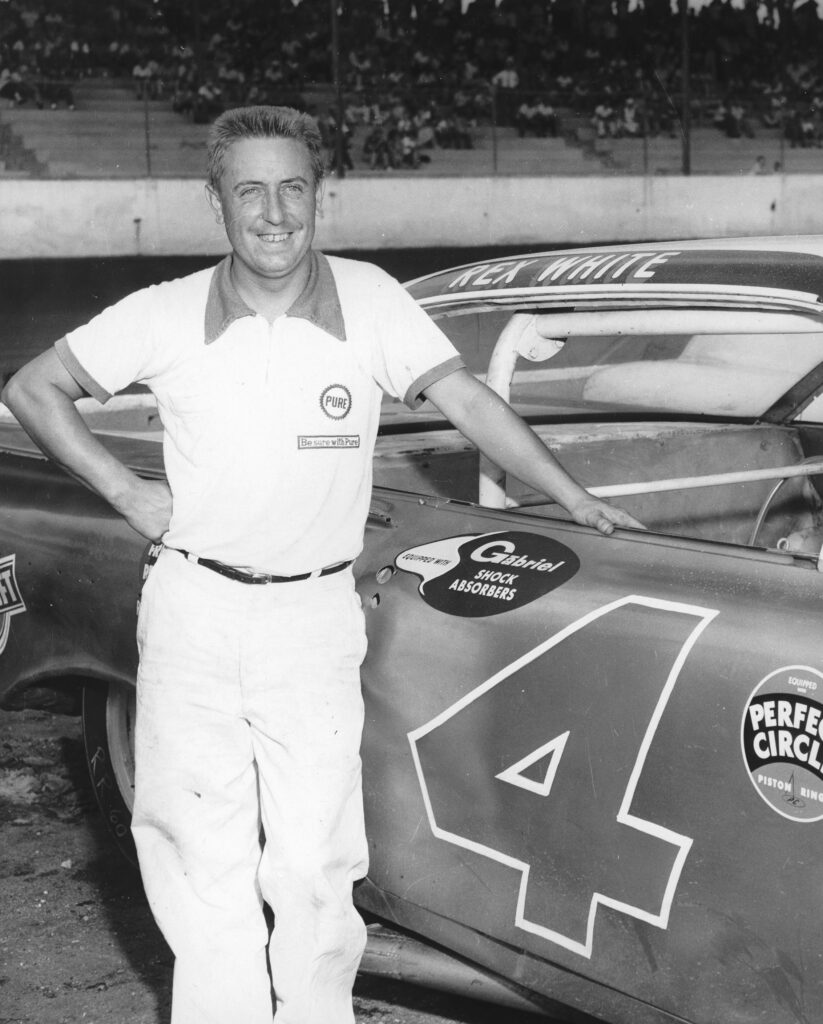By Ben White
A native of Taylorsville, North Carolina, Rex White came to stock car racing’s elite arena in 1956 after building a successful short-track career around the state of Maryland during the early 1950s. He retired from NASCAR racing in 1964 with 28 Cup Series victories.
Two years later, White returned to short-track Sportsman competition to shake off some remaining desire. Over one four-day weekend, he collected five consecutive victories at tracks in Columbia, South Carolina, on Thursday night; Asheville, North Carolina, on Friday night; North Wilkesboro, North Carolina, on Saturday afternoon; Shelby, North Carolina, on Saturday night; and Spartanburg, South Carolina; on Sunday afternoon.
White operated a successful business for decades and returned to NASCAR after being inducted into the NASCAR Hall of Fame in 2015. Now, at age 94, he enjoys reflecting on the days when he was a top competitor in NASCAR’s premier stock car series.

How did you come up with the iconic gold-and-white No. 4 paint scheme that you made so famous?
I always liked the gold color. I had never taken the time to paint that color on any of my Sportsman cars. When I got to the Grand National Series, what’s now the Cup Series, I decided it was time to do that. A guy named Wally Campbell had a car that was painted gold. That’s really how I picked gold for my car. Mine was gold on the sides and white on the hood, top and trunk or deck lid. We also had red No. 4s on the doors and roof.
Who was the driver you respected the most during your career?
I respected a guy named Frankie Schneider the most. He ran in NASCAR from 1949 to 1958. After that, I didn’t get to communicate with him much. As far as other drivers, I liked Marvin Panch really well. We got along very well together during my years as a driver in NASCAR.
Who did you have the most run-ins with?
Guess that would have to be Lee Petty. We bent fenders on our cars and got in each other’s way from time to time.
Can you talk about the chemistry you had with your crew chief, Louis Clements. You two won some races together.
Oh, yes. Louis and I got along great. With Louie, it didn’t matter what you were working on, he was good at doing anything. He had a great mind for building engines and working on the car. We worked very well together. Chevrolet had race teams and both he and his brother, Crawford, went to work with them and were a great help for them.
What did you enjoy most about your career in NASCAR?
That’s a real simple answer: winning races. Also, winning the 1960 championship. That year, everything came together for us. We won six times (along with 25 top-five finishes and 35 top-10 results). We worked hard for it. That was a great year. Winning the 1960 NASCAR championship meant everything to me. It really did. In those days, the previous year’s champion received money over what was won the next year and that really came in handy.
What was racing like during your career?
I started off racing at West Lanham (Maryland) Speedway outside Washington, D.C. That was a tough track to drive. It was a good race track and where I got my first win. I would say that was pretty much the toughest track of anywhere I raced.
What was driving on the superspeedways like during your era?
They weren’t too bad for me. Back in 1958, I drove around Daytona International Speedway with Billy France (Bill France Jr.) in a 1958 Pontiac before it was ever paved. A lot of people drove through the entrance tunnel (after its completion in February 1959) and looked at that race track and they were scared of it. I didn’t ever have a problem with the race track at all. I really started learning the draft and got used to it pretty quickly.
In 1963, the new Chevrolet that year had a 348 cubic-inch engine. Then, we had the 428 cubic-inch engine and I got around the place a lot better.
Competing in NASCAR during that era was hard work for every driver and team but it was also very rewarding, would you agree?
Oh, yeah. You bet. It was very, very rewarding for me. I really enjoyed my time in NASCAR.
What would you consider your greatest victory in NASCAR?
The 1962 Dixie 400 at Atlanta was the biggest race that I won. Marvin Panch was leading in the Wood Brothers Ford at the end of the race. We were different on gas than everyone else and Louie kept flashing to me “Gas” and a question mark on our pit board. We figured we’d have to pit before the end anyway. I really didn’t try to race Marvin there with the laps winding down. I drafted him and saved all the gas that I could. He ran out of gas and I won the race.
How did the cars drive in that era of racing? They were pretty much stock, other than a few safety modifications?
You had to work on the car so you could get the springs working right. You had to make sure the tires you picked out were working. You had to do a lot to get your car to work right on the track. The key was to get your car to work throughout the race and not to be that far off as the finish approached. Then, you would adjust the car near the end, and go out and try to win.
Describe how it felt to win the 1960 NASCAR Cup Series championship.
It was definitely the biggest thrill of my life, other than being inducted into the NASCAR Hall of Fame in 2015. When I won the championship in 1960, it was the biggest accomplishment I ever achieved.
